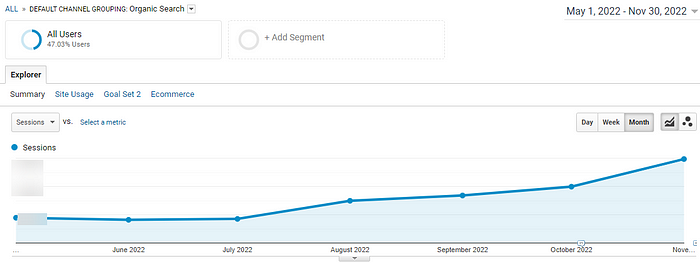Industry
Real Estate & Vacation
Challenges
Too many non-indexable URLs, lack of correct URL structure, on-page SEO elements and proper content categorization, poor page speed
Outcome
Large-scale implementation of technical SEO, URL migration, content planning, 232% increase in organic traffic in 6 months, 381.59% increase in non-homepage organic traffic in 6 months, 233.9% increase in number of conversion coming from organic search
Basic info
2022, with all its difficulties and beauties, is almost over. However, despite all the challenges, we completed this year with two excellent SEO case studies in the field of technical SEO. One of these studies was on vacation, and the other was in the banking & finance sector.
Here, I share the details of the first of these case studies with you in this content:
Main Issues
URL Structure & Click Depth: Most product/service pages didn’t have target keywords. And the other main problem is that important pages have high click depth. These two issues exacerbated the problem of pages not having high rankings.
Targeting Wrong User Intent & Keywords: This client had suffered from targeting wrong keywords that didn’t have a powerful impact on reaching the right users on Google SERP.
Crawlability & Indexability Issues: 45% of URLs have canonicalization issues on this website, and it caused inefficient use of the crawl budget.
Hundreds of Unnecessary URLs Due To CMS: Like most content management systems, this client had a serious problem with numerous URLs which is unnecessary.
Content Focus & Strategy: Even if the client had been creating content on their website regularly, they needed to be aware of the benefits of focusing on the main topics.
Let’s go back to the beginning of this story:
Services
- Technical SEO
- On-page SEO
- Off-page SEO
URL Structure, Click Depth & Crawlability

After our kick-off meeting with the client and the first technical SEO crawl in May 2022, we noticed that most of the important pages, including high-potential product pages, have more than three click depth and are not optimized for the right target keywords.
We’ve updated the internal linking strategy to fix the crawl depth issue. To achieve this goal, we have two main aspects:
- Make architecture shown correctly and meaningful URLs more crawlable
- Content silos with internal links
Thanks to this internal linking optimization, each page is linked to the pages it is most relevant to.
Thanks to this internal linking optimization, each page is linked to its most relevant pages.
As we completed the new URL structure and first-phase SEO developments, the website started getting rankings for more keywords, which was just the beginning.
Identifying The Right Keywords & Building Authority Over Specific Searches
We ran brilliant keyword research & competitor analysis to figure out the best keywords that would bring good traffic and convert users. We used a strategy for dominating category niches and building authority on these specific niche content.
Before we got involved in this SEO project, the client had written and published more than 120 pieces of content, but most of them couldn’t get high rankings which drove a high amount of organic traffic.
At the end of this comprehensive analysis, we updated all SEO elements around these new target keywords that will provide more traffic & leads.
Minor Update on Robots.txt & Sitemap Files
We also updated default robots.txt and sitemap files that open-source CMS generated to make the right pages indexable and prevent wrong pages from crawling.
Core Web Vitals Optimization
The other main issue was poor page speed and user experience on all pages. As I mentioned, this client has an open-source CMS, and most of the issues prevent it from boosting its page speed. So, this was one of the most challenging parts to optimize.

Despite the open-source CMS infrastructure, we applied tailor-made one-by-one solutions for each page speed issue. Firstly, we detected problem sources exactly and then:
- PNG and JPEG image formats turned into WebP, which is lighter and faster than other image formats.
- Implemented Redis Cache on the server side to boost caching capability
- Minimized text sources and got rid of unnecessary JavaScript & CSS sources
- Decreased JavaScript execution time
- Optimized image files which directly affected CLS score on mobile and desktop
- Fixed web fonts loading issue
Even if this development took a relatively long time, it greatly increased conversion rate and keyword rankings.
How Organic Traffic Changed in 6 Months?
We achieved great results at the end of this intensive work process.

After completing all technical SEO issues and updating the content strategy, monthly organic traffic increased by 232.30% compared to May 2022, which is the first month of the project.

When we examine the non-homepage organic traffic in order to evaluate this change more objectively, we see a 381.59% increase, which shows us the net increase is relatively free from the brand effect.

We encounter a similarly good picture in terms of YoY (year-over-year) performance comparison. Again, there is an over 288% increase in organic sessions.

As we analyzed keyword ranking performance, the client’s website had increased target keywords’ rankings and got more new keywords ranked. It raised its impressions and clicks respectively by 131% and 76%.
Organic traffic, visibility, and keyword rankings increased, and the monthly conversions from organic search increased by 234%.

If you also want to unveil your website’s potential and use organic as a revenue-driven channel, let’s make a quick call!
As your budget progresses and evolves, continue referring to your SMART objectives. Stay focused and remember your goals – they will always inform what your next step will be!


